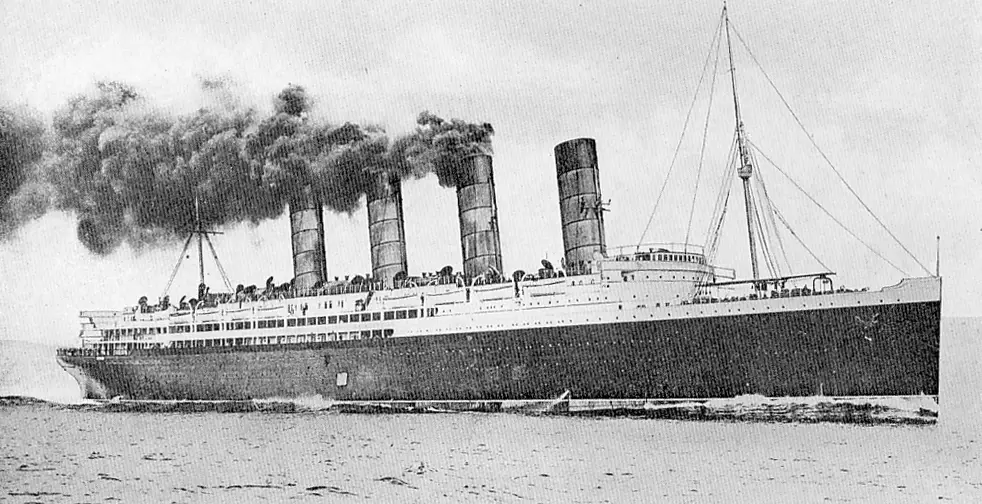The Sinking of the Lusitania
The sinking of the ocean liner Lusitania killed more than a thousand people and inflamed tensions between nations in the midst of World War I.
The ship was filled to the brim with passengers, including many well-known millionaires (like the famous businessman-sportsman Alfred Vanderbilt and George “Champagne King” Kessler), despite the presence in New York newspapers of warnings from the German Embassy that ships sailing into the European War Zone were potentially a target for German submarines, or U-Boats. (In fact, some newspapers printed this warning right next to a list of when the ships of the Cunard company would be sailing.) World War I, or the Great War as it was known then, began in 1914. Germany and Great Britain were enemies, and much conflict occurred in the waters around France, Germany, and Great Britain. Germany at this time had more than a dozen U-boats patrolling an expanding zone that included the North Sea, the Irish Sea, the English Channel, and the Atlantic Ocean. On February 18, 1915, Germany announced that it would sink Allied ships without warning. On the night of May 6, officers from the British Admiralty had sent warnings to the Lusitania crew of reports of U-boat activity off the southern Irish coast. The Lusitania crew put their passengers through more than one safety drill, but nothing further occurred. U20 was a German U-boat that, by early May 1915, had sunk a number of merchant ships and ocean liners. On May 5, U20 had sunk another large ship, a merchant ship, but not before boarding it and then allowing the crew to escape in lifeboats. U20 was off the south coast of Ireland on May 7. The sub was on the way home and had only three torpedos left. The trip in May 1915 was nowhere near Lusitania’s first crossing of the Atlantic Ocean. The ship launched in 1907 and racked up more than 200 trips back and forth in the eight years before the incident. In the ship’s first eastbound crossing after the war began, officials painted the ship a drab color in order to accentuate the look of a passenger ship. Also at this time, Britain was in the habit of using liners of various sizes to transport troops and weapons.
Whether or not the crew of U20 knew this (and historians still cannot agree on this), the submarine fired a torpedo at Lusitania at 2:09 p.m., when the liner was in sight of Old Head of Kinsdale, on the Irish coast. The Lusitania captain, William Turner, had noted his concern that he didn’t see any other ships in the area. No British ships were escorting Lusitania, unlike on a crossing in March, when two destroyers sailed along with Lusitania on the troop from New York to Liverpool. No German above-water ships were in the area. But under the water was U20. The torpedo struck the ocean liner on the starboard side, just behind the bridge; and the huge boat sank in just 18 minutes. In all, 1,195 passengers and crew drowned. More than 100 of these were American. The rest were Britons and Canadians. U20 fired just one torpedo, which caused an initial explosion. A second explosion occurred a bit later, accelerating the sinking of Lusitania, 11 miles off the Old Head of Kinsdale. Lusitania had 48 lifeboats, but the crew managed to lower only six successfully. Many people ended up in the water, which was very cold; and many people died in the water, before help arrived. Several hundred people survived, and word of the sinking spread quickly around the world. Outraged officials of the American and British government protested to the German government, which rescinded its naval “sink on sight” policy. Public opinion in America turned sharply against Germany after the sinking of the Lusitania. However, it was another two years before American troops fought in World War I. |
|
Social Studies for Kids
copyright 2002–2025
David White



 On May 1, 1915, the Lusitania, an ocean liner from the world-renowned Cunard company, set sail from New York. The destination was Liverpool. On board were 1,959 people in all, 1,265 passengers and 694 crew.
On May 1, 1915, the Lusitania, an ocean liner from the world-renowned Cunard company, set sail from New York. The destination was Liverpool. On board were 1,959 people in all, 1,265 passengers and 694 crew. The United States did not enter the war until 1917; so technically, the Lusitania, flying the flag of the U.S., was a neutral ship. Later investigations have found, though, that the Lusitania, in addition to transporting all of those passengers, was carrying a large amount of ammunition.
The United States did not enter the war until 1917; so technically, the Lusitania, flying the flag of the U.S., was a neutral ship. Later investigations have found, though, that the Lusitania, in addition to transporting all of those passengers, was carrying a large amount of ammunition.

